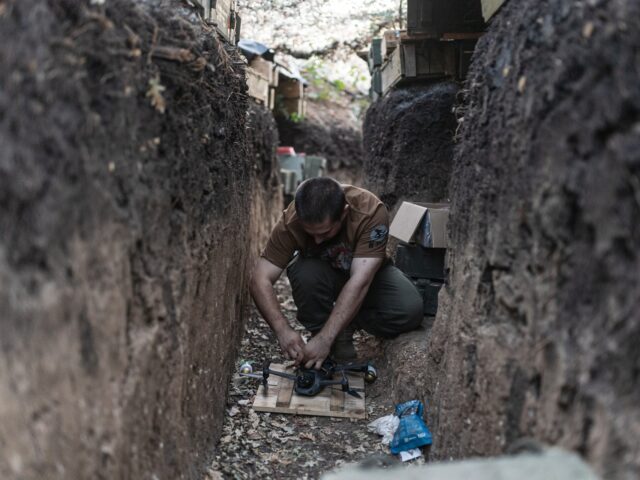The Russian government began evacuating residents from the Belgorod region on Monday in response to an ongoing Ukrainian invasion across the border.
Russian state media reportedly indicated that as many as 11,000 people in Belgorod will have to abandon their homes at least temporarily as Ukrainian troops reinforce their presence in neighboring Kursk, where Russian strongman Vladimir Putin denounced a “major provocation” by Ukrainian forces on August 6. Ukrainian President Volodymyr Zelensky has not directly addressed his push into Russia in detail, but suggested in recent comments that Russia must “feel war” to understand the gravity of its invasion of Ukraine and conceded that Kyiv was putting “pressure on the aggressive” in vague comments on Saturday.
Putin’s regime initially began invading Ukraine in 2014, “annexing” its Crimean peninsula. In February 2022, Russia upgraded its support of restive separatist groups in the region into a full-scale invasion that has persisted to this day, intended to topple Zelensky in response to the ouster of Russia-friendly Ukrainian President Viktor Yanukovych in 2014. Zelensky became president in an election widely considered free and fair in 2019 and had no involvement in the crisis surrounding Yanukovych, as he was working as a professional comedian at the time.
“In the interest of public health and safety, we’re starting to move people who live in Krasnoyaruzhsky to safer locations,” Governor Vyacheslav Gladkov of Belgorod announced on Monday in a statement on the encrypted messaging application Telegram. The Moscow Times, which translated the message, estimated that over 76,000 people have been evacuated from both Bolgorod and Kursk, where active hostilities between Ukrainian and Russian forces are believed to be underway at press time. Leaders in Kursk have also expanded already existing evacuation provisions.
Russian military leaders reportedly redirected forces into both regions and a third neighboring region, Bryansk, on Friday, responding to a mounting Ukrainian presence on Russian soil.
Putin addressed the nation on Monday, promising Ukraine would “receive a proper response” to its operations. He also suggested that he expects Ukrainian forces to threaten Bryansk imminently.
“If it is relatively calm in the Bryansk Region today, this does not mean that the same situation will remain there tomorrow,” Putin said, according to Russian state outlet Sputnik. “I ask you to take this very carefully together with the law enforcement agencies, together with the headquarters, which is being created through the FSB of Russia with the support of Rosgvardiya.”
“The main thing now is to solve the urgent problems that are emerging at this point in time,” Putin said, demanding his officials “ensure a counter-terrorism regime and an effective fight against enemy sabotage and reconnaissance groups.”
Tass, another Russian news agency, reported on Monday that authorities have documented 17 people killed and over 230 injured “along the line of engagement,” including 98 injured in Kursk and 70 in Belgorod.
Russian officials confirmed the presence of Ukrainian forces in Kursk on August 6, estimating hundreds of troops crossing the border. By Friday, Moscow had declared a federal-level state of emergency over the situation in Kursk and Ukraine, while not overtly admitting it, was hinting to an expansion of the war into Russia.
“A significant part of the global community considers Rf [the Russian Federation] a legitimate target for any operations and types of weapons,” top Zelensky adviser Mykhaylo Podolyak wrote on social media.
Zelensky himself declared last week that Russia launched the war “and it should feel what it has done,” a comment many interpreted as affirmation of the ongoing attacks in Kursk.
On Saturday, Zelensky said in public statements that he would continue to pursue “pressure on the aggressor” and the state outlet Ukrinform reported that Zelensky received a report from his top commander on “the pushing of the war into the territory of the aggressor.” The Ukrainian president identified Belgorod and Kursk by name as regions that Russia uses to launch airstrikes on civilian locations in his country, justifying the need to enter them.
Forbes, citing local Russian reports, said on Sunday that evidence is mounting that Ukrainian forces are digging trenches in Kursk, an indication they are expecting to maintain a long-term presence in the Russian territory. Forbes reported that Ukraine has moved “up to five 2,000-person brigades plus at least one 400-person independent battalion” and “industrial excavators” into Kursk. The successful building of trenches could result in a months-long struggle to control Kursk and, if successful, may allow Ukraine to expand attacks into other territories such as Belgorod.
The Moscow Times reported some growing alarm and anger at the Russian government from the displaced population of Kursk.
“Nobody cared about us,”one resident lamented. “The refugees from ‘that country’ were given everything at once … and [local] people left for nowhere and with nothing.”
The unnamed individual was referring to Ukrainians from “annexed” territories that Putin strove to displace into Russia to cement his control over the regions in question.
“Why did our state allow this? If you can’t protect your people, do an evacuation. As a result, there are victims again,” another resident was quoted as saying.
Follow Frances Martel on Facebook and Twitter.

COMMENTS
Please let us know if you're having issues with commenting.